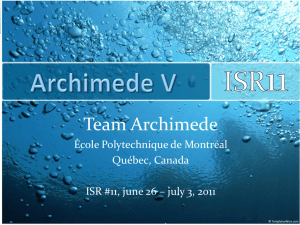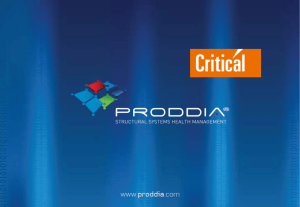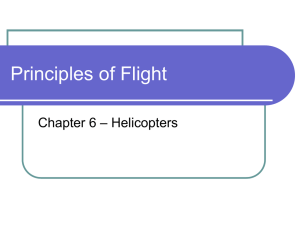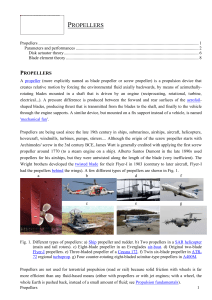AER710Propeller2
advertisement
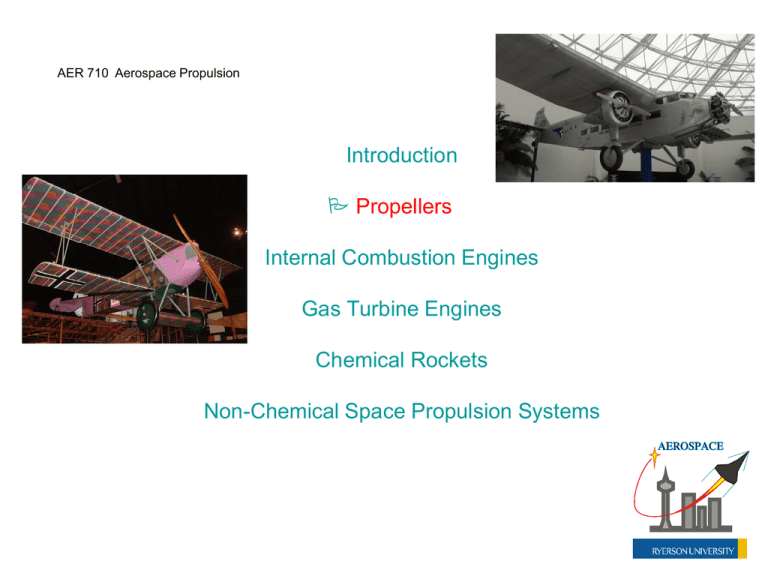
AER 710 Aerospace Propulsion
Introduction
Propellers
Internal Combustion Engines
Gas Turbine Engines
Chemical Rockets
Non-Chemical Space Propulsion Systems
C-130
Nieuport N.28C-1
Introduction to the Propeller
• The rotating blade of a propeller shares
similar characteristics to a wing passing
through the air
• A propeller blade generates thrust F through
an aerodynamic lift force component,
demands an engine torque Q to overcome
aerodynamic drag, and will stall if the local
resultant angle of attack of the blade
exceeds
• Additional factors: trailing vortex generation,
tip losses, compressibility
max
Martin MB-2
DH-98 Mosquito
Forces acting on wing airfoil section (above) and propeller blade section (below)
Actuator Disk Theory
• For evaluation of propeller performance, one can
apply a simple analytical approach using the
principle of linear momentum conservation, and
treating the propeller as an actuator disk where
there is a step increase in pressure
Thrust generated by disk:
( V3 V0 ) A3V3 ( V3 V0 )
F m
Alternatively:
F A1 ( p2 p1 )
Bernoulli’s eq. applied from upstream to front of disk:
1
1
2
p0 V0 p1 V12
2
2
Similarly, downstream of disk:
1
1
2
p 2 V2 p3 V32
2
2
Noting po = p3 , and V2 = V1, via subtraction one gets:
1
1
2
2
p 2 p1 ( V3 V0 ) ( V3 V0 )( V3 V0 )
2
2
Conservation of mass, incompressible flow:
A3V3 = A1V1
Substituting from earlier:
F A1 ( p2 p1 ) A3V3 ( V3 V0 )
and
A3
1
p2 p1 V3 ( V3 V0 ) ( V3 V0 )(V3 V0 )
A1
2
which gives the simple result:
V3 V 0
V1
2
Define propeller-induced velocity w such that:
V1 V0 w
V3 V0 2w
and so for thrust,
F A1V1( V3 V0 ) A1( V0 w )(V0 2w V0 ) 2A1( V0 w )w
Ideal power required:
P
or
1
1
1
m V32 m V02 A1 ( V0 w )[( V0 2w ) 2 V02 ] 2 A1 w( V0 w ) 2
2
2
2
P F( V0 w )
Since power from a piston or turboprop engine is relatively
constant at a given altitude, one can expect the thrust to
drop as the airplane picks up airspeed, according to this
correlation.
If one wishes to find w as a function of F, from earlier:
( 2A1 )w2 ( 2A1V0 )w F 0
giving
V0 1
2F
2
w
V0
2
2
A1
Ideal static power (Vo = 0):
Po Pind ,o Fo wo
Fo3 / 2
2 A1
Ideal propeller propulsive efficiency:
pr ,i
FV0
F ( V0 w )
1
1
or via substitution (q is dynamic pressure):
pr ,i
2
1 1
F
qA1
w
V0
Actual propeller propulsive efficiency, in terms of useful
(thrust) power and engine shaft power PS :
FV
pr
pr ,i
PS
Correction factor, less than 1, for ideal power estimate:
P F( V0 w ) ( correctionfactor) PS
Variable-pitch propeller better able to approach the
ideal power requirement, as compared to a fixed-pitch
propeller, in accommodating different flight speeds
and altitudes.
Momentum-Blade Element
Theory
• Logically, the next level of analysis would
look at a given propeller blade’s
aerodynamic performance from hub to
blade tip
• one can discretize the blade into a finite
number of elements, while applying
momentum conservation principles
Schematic diagram of a three-bladed propeller, and framework for discretizing an individual blade for analysis
Increment of thrust:
dF dL cos( i ) dD sin( i )
Resultant velocity:
V R ( r ) 2 V2
Increment of torque:
dQ rdFQ r [ dL sin( i ) dD cos( i )]
Increment of lift:
1
dL VE2 cC dr
2
Increment of drag:
1
dD VE2 cC d dr
2
Overall resultant velocity:
VE ( r w sin( i )) 2 ( w cos( i ) V )2
Induced angle of attack:
w
i sin ( )
VR
1
Airfoil lift coefficient:
C C ( i ) ao ( i )
Airfoil drag coefficient:
Cd Cd ,min
Cd Cd ,min k( C C ,min )2
Cd Cd ,max k1( max )
C < C,min
C,min < C < C,ma
> max
Via substitutions, increment of thrust:
dF dL cos
B
VR2 ca o ( i )dr cos
2
where B is number of blades.
Borrowing from actuator disk theory:
dF 2 dA ( V0 w )w 2 dA ( V w cos )w cos
2( 2rdr ) ( V iVR cos ) iVR cos
Equating the above relations, one arrives at:
cao B
cao B
V
(
) i
( ) 0
VR cos 8r cos
8r cos
2
i
Overall propeller solidity:
ref
bladearea B c ref R Bcref
2
diskarea
R
R
Local solidity:
Bc
Bc
x
R
r
x = r/R
Advance ratio:
J
V
V
V
nd p ( /( 2 ))( 2R ) R
where n is the prop shaft rotation speed (rps).
Nondimensional velocity ratio:
V
J
R
Also:
V
1
tan ( ) tan ( )
r
x
1
VR cos r xVT
VT = R
Substituting from earlier:
(
2
i
x
aoVR
2
8x VT
) i
aoVR
2
8x VT
( ) 0
Applicable solution for induced angle of attack via the
above quadratic eq. gives:
1
aoVR
aoVR 2 aoVR
i { ( 2 ) [( 2 ) 2 ( )]1 / 2 }
2
x 8x VT
x 8x VT
2 x VT
Propeller thrust coefficient:
F
CT
n 2 d 4
Propeller power coefficient:
PS
CP 3 5
n d
PS Q
Incremental thrust no. of blades:
1
dF VE2 Bc [ C cos( i ) C d sin( i )] dr
2
Incremental power no. of blades:
1
dPS r VE2 Bc [ C sin( i ) C d cos( i )] dr
2
Note:
2r 2 2
2 2
V V V r
(
J
x )
2
2
E
2
R
2
2
2
Thrust coefficient:
2
CT
F
2 4
4 R
2
1
2
2 2
CT
d
F
(
J
x )[ C cos( i ) C d sin( i )] dx
2 4
8x
4 R
h
Power coefficient:
3
CP
P
3 5 S
4 R
3
2 1
CP
dPS
x( J 2 2 x 2 )[ C sin( i ) C d cos( i )] dx
3 5
8 x
4 R
h
Momentum-Blade Element
Theory (Summary)
• The above equations for CT and CP can
be integrated from the hub station (x = xh)
to the blade tip (x = 1) using a numerical
approach as one moves along the blade of
varying and c, calculating the various
pertinent parameters (C , Cd, i , etc.) in
conjunction
Power
Thrust
Propeller Propulsive Efficiency
• Define as useful thrust power over overall
shaft power:
pr
FV
PS
Also, via substitution:
pr
CT n 2 d 4V CT
J
3 5
CP
C P n d
A variable pitch propeller will have better efficiency over the
course of the flight mission, relative to a fixed pitch prop.
Chart illustrating propeller propulsive efficiency for an example propeller
Compressibility Tip Loss
• Depending on the blade airfoil section
design, drag divergence (compressibility)
effects will become evident when the
propeller blade’s resultant tip speed VR,tip
exceeds a local flow Mach number Matip of
around 0.85 (critical value, Macr)
• As a result, one would not typically be
cruising at much greater than a flight Mach
number Ma of around 0.6
Blade tip Mach number:
Ma tip (
nd
a
) 2 Ma 2
Dommasch correlation:
pr pr,nominal
15 Matip Macr
(
)
100
0.1
Modern high-speed blades may be thinner, and swept
or curved along the blade length, to mitigate the
issues with compressibility and compression wave
development at higher local flow Mach numbers
Activity Factor
• Activity factor (AF) is a design parameter
associated with the propeller blade’s
geometry. The more slender the blade
(larger radius, smaller chord), the lower
the AF value:
100000
AF
16
1
c
3
x
x d p dx
h
c
AF 1563
dp
Typically see higher AF props on turboprop engines.
Blade Number
• One has the option of setting the number
of blades, B, for a given application. While
one has a minimum of 2 blades to choose
from, one can presently go as high as
around 8 blades on the high-performance
end for an unducted propeller
• On occasion, one also sees the use of two
contra-rotating rows of blades, to get more
thrust delivery from one engine
Photo of Fairey Gannett carrier-borne anti-submarine/AEW aircraft,
employing two contra-rotating rows of 4 propeller blades each on a co-axial
shaft setup, powered by a 3000-hp Armstrong Siddeley Twin Mamba
turboprop engine
Airbus A400M “Atlas”
Helicopter Rotors
• helicopter rotors (main and tail) share a
number of similarities with airplane
propellers
• analysis done above for propellers can be
applied to rotors
• orientation of the rotor disk will be
somewhat different from that of the
propeller, with respect to the resultant
incoming air flow
• Main helo rotor produces lift + thrust
- rotor blade will advance into the air flow when
in forward flight, and then retreat during the
other half of the rotational cycle
CH-47
- tail rotor primarily controls yaw forces and
moments [primarily main-rotor-induced
torque] on the helicopter, if only having one
main rotor
- a tandem-rotor helicopter, with two contrarotating main rotors, would not need a tail
rotor
- ducted tail fan is an alternative to the conventional
tail rotor
HH-65 Dolphin
NOTAR
No Tail Rotor (Using Coanda Effect)
• The amount of lift generated by a main rotor is controlled
by two means: a) the engine throttle setting for desired
level of main rotor rotational speed, and b) collective
pitch setting, which sets the angle of incidence of the
main rotor blades collectively to produce the desired
uniform lifting force on the vehicle (e.g., higher lift
required, a higher blade incidence angle setting is
needed, for the same rotor rotational speed)
• Rotation of the vehicle’s body in pitch or roll or some
combination thereof is largely via the cyclic pitch setting
of the main rotor, whereby the individual main rotor
blades will have their incidence vary as they complete a
given revolution about the vehicle, depending on the
desired direction of the rotational moment
Operations of swashplate (item #2, 4 above) for cyclic control
The schematic diagram illustrates a conventional main rotor mast
(rotorhead), with the hub above the mast connecting the rotor blades to the drive
shaft in a fully articulated design (hinged); a swashplate approach is being used to
control the effective main rotor disk deflection and tilt direction thereof
Fully articulated, a.k.a., hinged (horiz. + vert.) rotor head above
(vs. rigid, a.k.a., hingeless)
From: Flight International 1986
Bell UH-1C Iroquois (“Huey”)
Rotor mast, Bell UH-1 Iroquois
Hybrid Aircraft Designs
• In order to improve range performance
over a conventional helicopter, one will
see tilt-wing and tilt-rotor designs for
V/STOL (vertical/short takeoff & landing)
applications
Tilt-rotor V-22 Osprey
Tilt-wing Canadair CL-84
